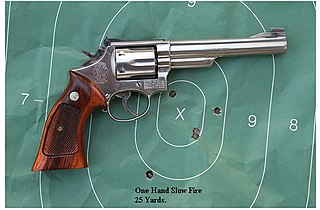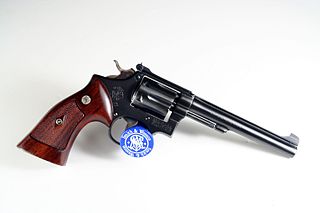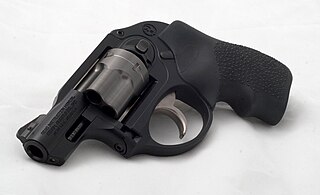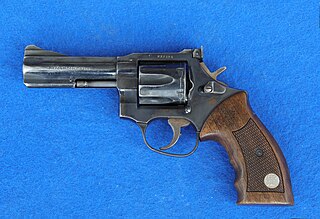
The Smith & Wesson Model 19 is a revolver produced by Smith & Wesson that was introduced in 1957 on its K-frame. The Model 19 is chambered for .357 Magnum. The K-frame is somewhat smaller and lighter than the original N-frame .357, usually known as the Smith & Wesson Model 27. A stainless steel variant of the Model 19, the Smith & Wesson Model 66, was introduced in 1971.

The Smith & Wesson Model 10, previously known as the Smith & Wesson .38 Hand Ejector Model of 1899, the Smith & Wesson Military & Police or the Smith & Wesson Victory Model, is a K-frame revolver of worldwide popularity. In production since 1899, the Model 10 is a six-shot, .38 Special, double-action revolver with fixed sights. Over its long production run it has been available with barrel lengths of 2 in (51 mm), 3 in (76 mm), 4 in (100 mm), 5 in (130 mm), and 6 in (150 mm). Barrels of 2.5 inches (64 mm) are also known to have been made for special contracts. Some 6,000,000 of the type have been produced over the years, making it the most-produced handgun of the 20th century.

The Smith & Wesson Model 586, is a six- or seven-shot double-action revolver chambered for the .357 Magnum cartridge; it will also chamber and fire .38 Special cartridges. The Model 586 has a carbon steel construction and is available in a blued or nickel finish; it is essentially the same firearm as the Model 686, which has stainless steel construction. It is also known as the Distinguished Combat Magnum.

The Smith & Wesson Model 686 is a six- or seven-shot double-action revolver manufactured by Smith & Wesson and chambered for the .357 Magnum cartridge; it will also chamber and fire .38 Special cartridges. Smith & Wesson introduced the Model 686 in 1981. It is the stainless steel version of the Model 586, which featured a blued steel finish. They are available ported and unported with a choice of 6- or 7-round cylinders.

In American English, a pocket pistol is any small, pocket-sized semi-automatic pistol, and is suitable for concealed carry in a pocket or a similar small space.

The Smith & Wesson Model 15, initially the Smith & Wesson K-38 Combat Masterpiece, is a six-shot double-action revolver with adjustable open sights produced by Smith & Wesson on the medium-size "K" frame. It is chambered for the .38 Special cartridge and is fitted with a 4-inch (100 mm) barrel, though additional barrel options have been offered at various times during its production. It is essentially a shorter barrel version of the Smith & Wesson Model 14 and an adjustable-sight version of the seminal Smith & Wesson Model 10 with target shooting features.

The Smith & Wesson K-22 Target Masterpiece Revolver is a six-shot, double-action revolver with adjustable open sights, built on the medium-size "K" frame. When introduced, it was intended for bullseye target shooting competition of the type then most common on the United States, which is today called NRA Precision Pistol, specifically in the "smallbore" or "22" category. It is chambered for the .22 Long Rifle cartridge. It is one of three similar models that Smith & Wesson offered, the other two being intended for the "centerfire" category, the K-32 Target Masterpiece chambered for the .32 S&W Long cartridge and the K-38 Target Masterpiece chambered for the .38 Special cartridge. Most K-22 revolvers were fitted with a 6 in (150 mm) or 8+3⁄8 in (210 mm) barrel, but other lengths have been produced. First produced in 1947 and originally known as the K-22 Target Masterpiece, it was numbered the Model 17 in 1957 when all Smith & Wesson guns were given numerical model numbers. It is built on the same frame as the seminal Smith & Wesson Model 10 revolver.

The Ruger Blackhawk is a six-shot, single-action revolver manufactured by Sturm, Ruger & Co. It is produced in a variety of finishes, calibers, and barrel lengths.

Charter Arms Co. is an American manufacturer of revolvers. Since its founding in 1964, Charter Arms has produced revolvers chambered in the following calibers: .22 Long Rifle, .22 Winchester Magnum, .32 Long, .32 H&R Magnum, .327 Federal Magnum, .38 Special, .357 Magnum, 9×19mm Parabellum, .40 Smith & Wesson, .41 Remington Magnum, .44 Special, .45 ACP, and .45 Colt.

The GP100 is a family/line of double action five-, six-, seven-, or ten-shot revolvers made by Sturm, Ruger & Co., manufactured in the United States. Since its introduction, it has been produced with a number of variations including various barrel lengths and profiles, fixed or adjustable sights, and in blued carbon steel or stainless steel.

A snubnosed revolver is a small, medium, or large frame revolver with a short barrel, generally less than 3 inches in length. Smaller such revolvers are often made with "bobbed" or "shrouded" hammers and there are also "hammerless" models ; the point is to allow the gun to be drawn with little risk of it snagging on clothing. Since the external movement of the mechanism is minimal or nil, shrouded and hammerless models may be fired from within clothing. The design of these revolvers compromises range and accuracy at a distance in favor of maneuverability and ease of carry and concealment.

The Colt Detective Special is a six-shot, carbon steel framed, 2-inch (5.1 cm) or 3-inch (7.6 cm) barreled, double-action revolver, and the first example of a class of firearms known as "snubnose revolvers". Made by Colt's Manufacturing Company, this model revolver, as the name "Detective Special" suggests, was intended to be a concealed weapon used by plainclothes police detectives.

S&W Centennial is a family of revolvers made by Smith & Wesson on the "J-Frame". Depending upon caliber, the cylinder holds either 5, 6, 7, or 8 cartridges. Centennials feature a fully enclosed (internal) hammer, which makes them Double Action Only (DAO) firearms. Like all other "J-frame" Smith & Wesson revolvers, they have a swing-out cylinder. Centennial models have been made in different versions like PD "Personal Defense", LS "Lady Smith", and M&P "Military & Police"

A handgun is a firearm designed to be usable with only one hand. It is distinguished from a long barreled gun which needs to be held by both hands and braced against the shoulder. Handguns have shorter effective ranges compared to long guns, and are much harder to shoot accurately. While most early handguns are single-shot pistols, the two most common types of handguns used in modern times are revolvers and semi-automatic pistols, although other handguns such as derringers and machine pistols also see infrequent usage.

The Colt Trooper is a medium frame, double-action revolver featuring a six-round cylinder, chambered for .22 Long Rifle, .22 Winchester Magnum Rimfire, .38 Special, and .357 Magnum caliber cartridges. Designed as a less expensive alternative to the upscale Colt .357 and the later Colt Python and Colt King Cobra, it was marketed to law enforcement agencies as well as civilians.

The Smith & Wesson Model 640 revolver is a 5-shot snubnosed revolver that is chambered in either .38 Special or .357 Magnum caliber introduced in 1989. Like other "J-frame" Smith & Wesson revolvers, it has a swing-out cylinder, but this model features a concealed hammer, and is part of the Centennial line.

The Smith & Wesson Model 57 is an 'N' frame (large), double-action revolver with a six round cylinder, chambered for the .41 Magnum cartridge, and designed and manufactured by the Smith & Wesson firearms company. The gun was designed as a weapon for law enforcement agencies. However, due to size and recoil it found more favor with civilian target shooters and hunters.

The Ruger LCR is a compact revolver built by Sturm, Ruger & Co. and announced in January 2009. LCR stands for "Lightweight Compact Revolver". It incorporates several novel features such as a polymer grip and trigger housing, monolithic receiver, and constant force trigger. At 13.5 oz (380 g), the LCR is nearly 50% lighter than the stainless steel SP101, as only the barrel and fluted cylinder are made of stainless steel.

The Manurhin MR 73 is a French double-action/single-action revolver chambered in .357 Magnum and .38 Special. It is manufactured by Manurhin and is available in 2.5", 2.75", 3", 4", 4.25”, 5.25", 5.75", 6", 8" and 10" barrel lengths.

The Smith & Wesson Bodyguard is a family of small J-frame revolvers with shrouded hammers manufactured by Smith & Wesson. They are available chambered in either .38 Special or .357 Magnum.
























